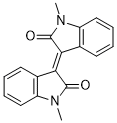Physicochemical Properties
| Molecular Formula | C18H14N2O2 |
| Molecular Weight | 290.31 |
| Exact Mass | 276.089 |
| Elemental Analysis | C, 74.47; H, 4.86; N, 9.65; O, 11.02 |
| CAS # | 97207-47-1 |
| Related CAS # | 97207-47-1 |
| PubChem CID | 126274 |
| Appearance | Red solid powder |
| Density | 1.4±0.1 g/cm3 |
| Boiling Point | 482.0±45.0 °C at 760 mmHg |
| Melting Point | 236-237ºC |
| Flash Point | 245.3±28.7 °C |
| Vapour Pressure | 0.0±1.2 mmHg at 25°C |
| Index of Refraction | 1.698 |
| LogP | 1.53 |
| Hydrogen Bond Donor Count | 1 |
| Hydrogen Bond Acceptor Count | 2 |
| Rotatable Bond Count | 1 |
| Heavy Atom Count | 21 |
| Complexity | 614 |
| Defined Atom Stereocenter Count | 0 |
| SMILES | O=C1C(=C2C3C(=CC=CC=3)N(C)C2=O)C2C(=CC=CC=2)N1 |
| InChi Key | XZYXCQXTKOYHGK-UHFFFAOYSA-N |
| InChi Code | InChI=1S/C17H12N2O2/c1-19-13-9-5-3-7-11(13)15(17(19)21)14-10-6-2-4-8-12(10)18-16(14)20/h2-9,21H,1H3 |
| Chemical Name | 3-(2-hydroxy-1-methylindol-3-yl)indol-2-one |
| Synonyms | Meisoindigo; N-Methylisoindigotin; Methyl isoindigotin |
| HS Tariff Code | 2934.99.9001 |
| Storage |
Powder-20°C 3 years 4°C 2 years In solvent -80°C 6 months -20°C 1 month |
| Shipping Condition | Room temperature (This product is stable at ambient temperature for a few days during ordinary shipping and time spent in Customs) |
Biological Activity
| ln Vitro |
Meisoindigo (Dian III; 5–20 M; for 24 hours) prevents AML cell lines from proliferating[1]. Meisoindigo (10 μM; for 24 hours) induces apoptosis of acute myeloid leukemia[1]. Meisoindigo (5-10 μM; for 24 hours) causes cell-cycle arrest[1]. Meisoindigo (5-10 μM; for 24 hours) elevates pro-apoptotic Bak and cleaved caspase-3 while lowering Bcl-2 and Bcl-xL levels in HL-60 cells[1]. Meisoindigo (10, 30, 50, 100, 150 μM; 24 hours) blocks NLRP3 inflammasome activation and M1/M2 polarization brought on by LPS (1 μg/mL) in HT-22 and BV2 cells by down-regulating TLR4 pathways after OGD/R[2]. |
| ln Vivo |
Meisoindigo (Dian III; 50–150 mg/kg; IP; daily; for 14 days) has anti-leukemic activity in vivo[1]. Meisoindigo significantly reduces infarct volume and improves neurological deficits 3 days after middle cerebral artery occlusion (MCAO) in Wild-type C57BL/6J mice (25-30 g) when administered intravenously (2, 4, 8, 12 mg/kg) prior to MCAO and 2 hours after reperfusion. Meisoindigo decreases brain edema and AQP4 expression[2]. |
| Animal Protocol |
HL-60, NB4, U937 leukemic cell lines 5, 10, 15, 20 μM IP; daily; for 14 days |
| References |
[1]. Meisoindigo is a promising agent with in vitro and in vivo activity against human acute myeloid leukemia. Leuk Lymphoma. 2010 May;51(5):897-905. [2]. Yingze Ye, et al. Meisoindigo Protects Against Focal Cerebral Ischemia-Reperfusion Injury by Inhibiting NLRP3 Inflammasome Activation and Regulating Microglia/Macrophage Polarization via TLR4/NF-κB Signaling Pathway. Front Cell Neurosci. 2019 Dec 16;13:553. |
Solubility Data
| Solubility (In Vitro) |
DMSO: ~55 mg/mL (~199.1 mM) Ethanol: ~1 mg/mL (~3.6 mM) |
| Solubility (In Vivo) |
Solubility in Formulation 1: ≥ 2.5 mg/mL (9.05 mM) (saturation unknown) in 10% DMSO + 40% PEG300 +5% Tween-80 + 45% Saline (add these co-solvents sequentially from left to right, and one by one), clear solution. For example, if 1 mL of working solution is to be prepared, you can add 100 μL of 25.0 mg/mL clear DMSO stock solution to 400 μL PEG300 and mix evenly; then add 50 μL Tween-80 + to the above solution and mix evenly; then add 450 μL normal saline to adjust the volume to 1 mL. Preparation of saline: Dissolve 0.9 g of sodium chloride in 100 mL ddH₂ O to obtain a clear solution. (Please use freshly prepared in vivo formulations for optimal results.) |
| Preparing Stock Solutions | 1 mg | 5 mg | 10 mg | |
| 1 mM | 3.4446 mL | 17.2230 mL | 34.4459 mL | |
| 5 mM | 0.6889 mL | 3.4446 mL | 6.8892 mL | |
| 10 mM | 0.3445 mL | 1.7223 mL | 3.4446 mL |
